Dornier Do 17
Le crayon volant - The flying pencil
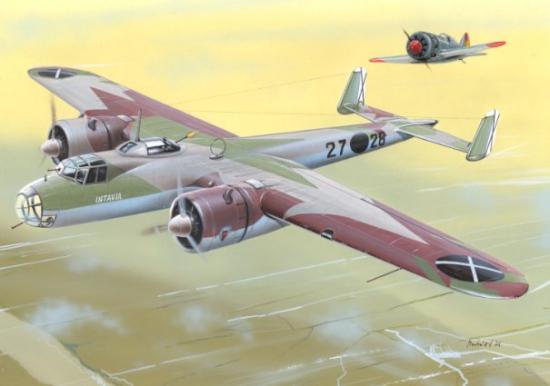
© RS MODELS - source : www.rsmodels.cz
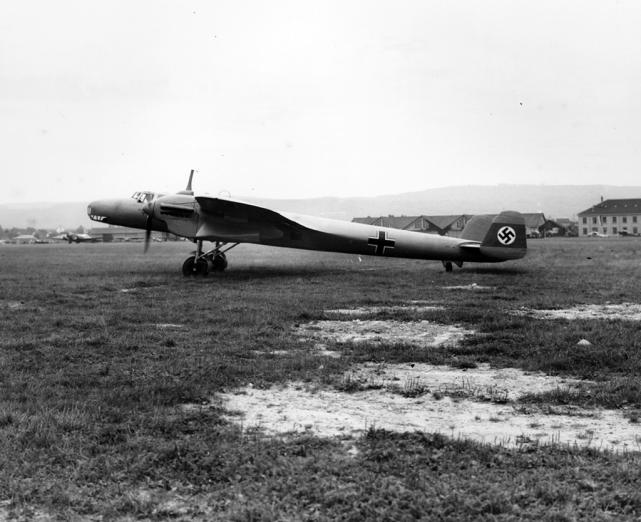
Photo : auteur inconnu - Author unknown
Le Dornier Do 17 était un bombardier rapide et léger. Equipé de deux moteurs radiaux et d'une queue double, il fut l'un des trois principaux types de bombardiers de la Luftwaffe utilisés pendant les trois premières années de guerre mais également pendant la guerre civile d'Espagne en 1937. Il était populaire parmi les équipages pour sa manoeuvrabilité à basse altitude qui rendait le Dornier Do 17 capable de bombardements surprises. Son fuselage lisse et mince le rendait plus difficile à atteindre que les autres bombardiers allemands.
The Dornier Do 17 was a rapid and light bomber. Equipped with two radial engines and a twin tail, it was one of the three main Luftwaffe bomber types used in the first three years of the war but also during the Spanish Civil War in 1937. It was popular among its crews due to its manoeuvrability at low altitude, which made the Dornier Do 17 capable of surprise bombing attacks. Its sleek and thin airframe made it harder to hit than other German bombers.
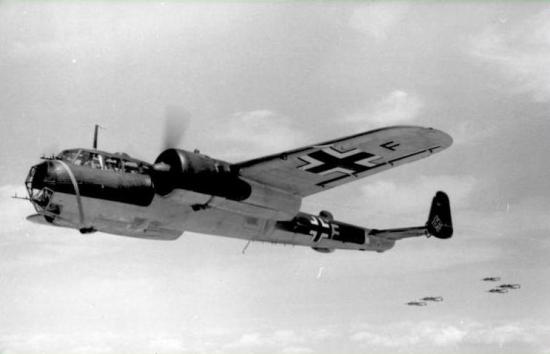
Do 17 Z - KG 76, France 1940. © Spieth - Bundesarchiv Bild 101I-341-0489-10A
(Cette image est soumise aux droits de Creative Commons Attribution ShareAlike 3.0 Germany License)
(This picture is licensed under Creative Commons Attribution ShareAlike 3.0 Germany License)
Le Do 17 fut utilisé jusqu'à la fin de 1941, quand sa charge de bombe et son rayon d'action devinrent trop limités ; la production s'arrêta fin 1941, au profit du nouveau et plus puissant Junkers Ju 88. Son successeur fut le Do 217, qui apparut en force en 1942. Cependant, le Do 17 fut utilisé jusqu'à la fin de la guerre dans des rôles de transport, test et entraînement. Un petit nombre d'une version améliorée, le Do 215, fut produit pour l'export mais servi finalement dans la Luftwaffe ; cette production cessa en janvier 1941.
The Do 17 was used until the end of 1941, when its bomb load and range became limited ; production ended in the summer of 1940, in favour of the newer and more powerful Junkers Ju 88. Its successor was the Dornier Do 217, which started to appear in strength in 1942. Even so, the Do 17 continued to be used in various roles until the end of the war, as a transport, test and trainer aircraft. A small number of an updated version, the Do 215, was also produced for export, but ended up in Luftwaffe service ; this production ceased in January 1941.
Développement - Development
En 1932, le ‘Heerswaffenamt' lança un cahier des charges pour un avion de transport pour les Chemins de Fer de l'Etat Allemand et pour un avion rapide pour le courier pour la Lufthansa. L'usine Dornier de Friedrichshafen commença la conception le 1er Août 1932. Quand les Nazis prirent le pouvoir en 1933, le RLM appela le nouvel avion Do 17. Fin 1933, le RLM passa une commande pour un "avion rapide à queue double" et pour un "avion de transport avec équipement spécial", en d'autres mots un bombardier.
In 1932 the Heereswaffenamt issued a specification for the construction of a "freight aircraft for German State Railways", and a "high speed mail plane for Lufthansa". The Dornier factory at Friedrichshafen began work on the design on 1 August 1932. When the Nazis had taken power in 1933, the RLM designated the new aircraft Do 17. At the end of 1933, the RLM issued an order for a "high speed aircraft with double tail," and for a "freight aircraft with special equipment," in other words, a bomber.
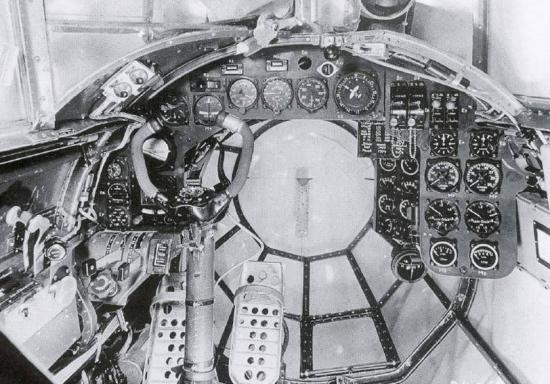
Do 17 - Cockpit. Origine photo inconnue - Photography origin unknown
Le modèle original (le Do 17 V1) avait un stabilisateur vertical simple mais Dornier continua le développement du modèle. La production de prototypes débuta le 20 mai 1934 et, le 23 novembre 1934, le Do 17 V1 à queue simple, motorise par deux moteurs BMW VI 7.3, effectua son premier vol. Les tests furent retardés par une série d'accidents à l'atterissage en février et avril 1935. Le V2 à queue double (motorisé par des moteurs BMW VI 6.3 à basse compression) vola pour la première fois le 18 mai 1935 et fut évalué en même temps que le V1 par le RLM en juin.
The original model (the Do 17 V1) had a single vertical stabilizer but Dornier continued developing that model. Production of prototypes began on 20 May 1934 and, on 23 November 1934 the Do 17 V1, with single vertical stabilizer, powered by two BMW VI 7.3 motors, took off on its first flight. Testing was delayed by a series of landing accidents in February and April 1935. The twin tailed V2 (powered by low-compression BMW VI 6.3 engines) first flew on 18 May 1935 and was evaluated together with the V1 by the RLM at Rechlin in June.
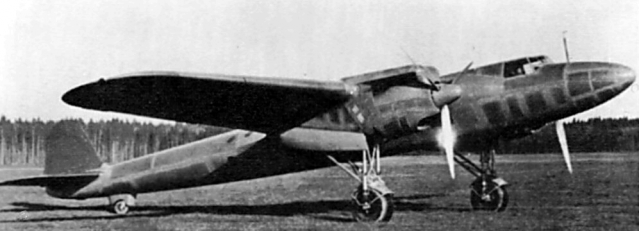
Do 17 V-1 Origine photo inconnue - Photography origin unknown
Pendant les tests, le stabilisateur vertical simple se révela moyennement stable, et le V1 fut modifié pour recevoir une queue double mais fut détruit par crash suite à un défaut moteur le 21 décembre 1935. Le V3, également à queue double, fut d'abord prévu avec des moteurs Hispano-Suiza 12Ybrs, mais ceux-ci étant indisponibles, fut équipé de BMW VI 7.3 comme le V1. Il vola le 19 septrembre 1935. Il est dit que le Do 17 V1 fut conçu comme un avion courrier avec six passagers pour concurrencer le Heinkel He 70 monomoteur.
During the tests the single vertical stabilizer proved to be only marginally stable, and the V1 was modified with a twin tail but destroyed in a crash after an engine failure on 21 December 1935. The V3, also fitted with a twin tail, was originally planned to be powered by Hispano-Suiza 12Ybrs engines, but as these were unavailable, it was fitted with BMW VI 7.3 engines like the V1. It flew on 19 September 1935. It is claimed that the Do 17 V1 was contracted solely as a fast six-passenger mail plane to compete with the smaller single engine Heinkel He 70.
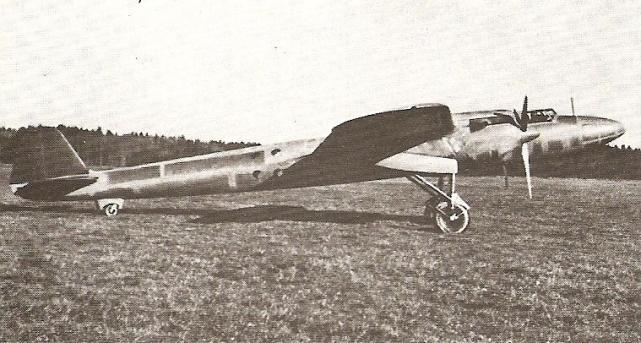
Do 17 V-1 Origine photo inconnue - Photography origin unknown
Selon cette version de l'histoire, il fut rejeté par la Lufthansa dans la mesure où la petite cabine était trop inconfortable pour les passagers et les coûts de fonctionnement pour du courrier étaient trop élevés. Les trois prototypes restèrent inutilisés à l'usien Dornier de Lowental pendant six mois, jusqu'à ce que le Capitaine Untucht pilota l'une des machines. Après l'atterissage, il dit : "donnez lui un peu plus de stabilité latérale et nous aurons un bombardier à grande vitesse !".
According to this version of the story, it was rejected by Lufthansa as the small cabin space was too uncomfortable for passenger use and the operating costs also were too high for a mail plane. The three prototypes remained unused in the Dornier factory in Lowental for almost six months, until Flight Captain Untucht flew one of the machines. After landing, he said : "give it more lateral stability and we'll have a high speed bomber !".
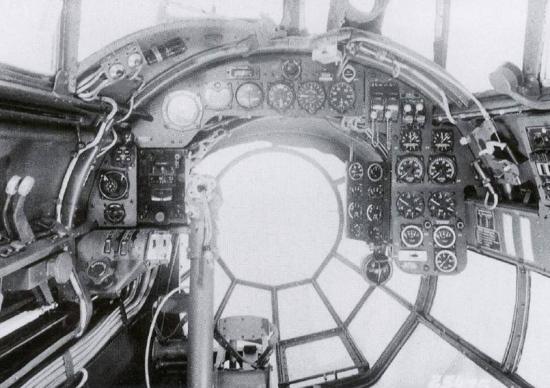
Do 17 - Cockpit. Origine photo inconnue - Photography origin unknown
Dornier reçu l'ordre de fabriquer le V4. Il différait du V3 par le stabilsateur vertical simple qui fut remplacé par deux plus petits. Les tests des prototypes "double-queue" Do 17 V4, V6 et V7 furent positifs et plus de prototypes apparurent comme le V8, précurseur d'une version de reconnaissance longue-distance, et le V9 testé comme un avion de ligne rapide.
Dornier was then ordered to produce the V4. This differed from the V3 in that the single vertical stabilizer was replaced with two smaller ones. The tests of the "twin-tailed" prototypes Do 17 V4, V6 and V7 were positive and more prototypes like the V8 emerged as the forerunner of long-distance reconnaissance version, while the V9 was tested as a high speed airliner.
Versions - Variants
Do 17E & F

Dornier Do 17E-1, Aufklärungsgruppe 88 - (Espagne - Spain).
© Vincent Dhorne

Do 17 E-1 - FFS(B)16.
Aux couleurs d'avant guerre mais avec les moteurs jaunes des avions d'entraînement.
With pre-war appearance and yellow engine noses (training aircrafts).
Artiste inconnu - artist unknown - source : http://wp.scn.ru/en/ww2/b/325
Les prototypes furent motorisés avec des moteurs Daimler-Benz DB 600, mais la production demarra avec les moteurs en ligne BMW VI, créant ainsi le bombardier Do 17 E-1 et l'avion de reconnaissance Do 17 F-1. La charge de bombe était de 500 kg, et il était armé de deux mitrailleuses défensives MG 15, une sur le toit de la cabine et une dans une petite trappe sur le plancher.
The prototypes were powered by Daimler-Benz DB 600 engines, but production started instead with the BMW VI inline engine, creating the Do 17 E-1 bomber and Do 17 F-1 reconnaissance versions. The bombload of the E-1 was 500 kg, and it was armed with two defensive MG 15 machine guns, one in a position on the cabin roof and one a small hatch in the floor.
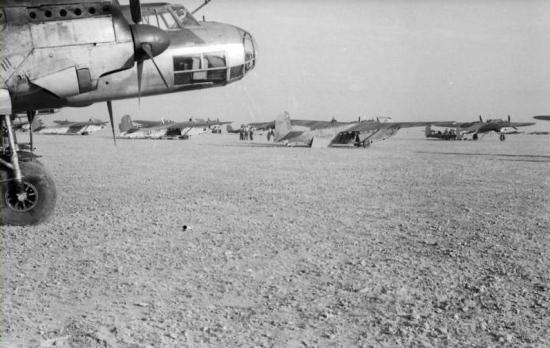
Do 17 E - (planeurs DFS 230 en arrière plan - Gliders DFS 230 in the background).
© Macioszek - Bundesarchiv Bild 101I-565-1407-35A
(Cette image est soumise aux droits de Creative Commons Attribution ShareAlike 3.0 Germany License)
(This picture is licensed under Creative Commons Attribution ShareAlike 3.0 Germany License)
Do 17K

Dornier Do 17 Ka-2 (Serial 3321) - 206. Eskadrila, 3. Bombarderski Puk.
Artiste inconnu - artist unknown - source : http://wp.scn.ru/en/ww2/b/325
Après avoir vu le Do 17 M V1 aux courses aériennes de Zürich en 1937, l'Armée de l'Air Yougoslave acheta la license de production pour l'usine de Drzavna Fabrika Aviona en 1938. Il l'équipèrent des moteurs radiaux plus puissants Gnome-Rhône 14N (bien que les Français aient exagéré ses performances) et ajoutèrent un canon Hispano de 20 mm et trois mitrailleuses Browning de 7,92 mm. Trois versions furent fabriquées en Yougoslavie. La première fut le bombardier Do 17Kb-1 et la seconde l'avion de reconnaissance Do 17Ka-2. La dernière version fut l'avion de reconnaissance Do 17Ka-3.
After seeing the Do 17 M V1 at the Zürich air races in 1937, the Yugoslavian Air Force bought licence rights for production at the Drzavna Fabrika Aviona factory in 1938. They equipped it with the more powerful Gnome-Rhône 14N radial engines (although the French exaggerated it its performance) and added a Hispano 20 mm cannon and three 7.92 mm Browning machine guns. Three variants were built in Yugoslavia. The first being the Do 17Kb-1 bomber aircraft and the second was the Do 17Ka-2 reconnaissance aircraft. The final variant was the Do 17Ka-3 reconnaissance aircraft.
Do 17L & M

Dornier Do 17M-1, 6./KG 2 - Septembre 1939 - September 1939.
Artiste inconnu - Artist unknown - Source : http://wp.scn.ru/en/ww2/b/325
Les Do 17 L-0 et Do 17 M-0 furent développés en parallèle pour remplacer les premiers E et F, le L étant une version de reconnaissance. Les deux furent conçus autour des moteurs plus puissant DB 600A, délivrant 1000 CV (750 kW). Deux versions L et une version M furent fabriquées en prototypes, les deux avec une MG 15 supplémentaire dans le nez. La performance du bombardier rapide fur démontrée à la Compétition Internationale d'Avions Militaires à Zürich en 1937, où le prototype du Do 17M finit devant tous les chasseurs en compétition. L'approvisionnement du DB 600 resta extrêment limitée car la production avait basculé sur le DB 601, réservé aux Messerschmitt Bf 109 et Bf 110.Les versions de production du Do 17M basique furent ainsi basculées sur deux nouveaux moteurs Bramo 323A-1 Fafnir de 900 CV (670 kW), ce qui lui conféra une performance raisonnable et augmenta la charge de bombes à 1000 kg. Le modèle résultant, le Do 17 M-1 fut fabriqué en petit nombre et opéra jusqu'à la première année de guerre puis fut retiré et envoyé en unités d'entraînement.
The Do 17 L-0 and Do 17 M-0 were developed in parallel as replacements for the earlier E and Fs, the L being the reconnaissance version. Both were designed around the more powerful DB 600A engines, delivering about 1,000 HP (750 kW). Two L and one M versions were built as prototypes, both with another MG 15 in the nose.
The feasibility of the fast bomber was demonstrated at the International Military Aircraft Competition at Zürich in 1937, where the Do 17M prototype finished ahead of all the fighters in the competition. The supply of the DB 600 remained extremely limited as production was soon switched over to the DB 601, reserved for the Messerschmitt Bf 109 and Bf 110. Production versions of the basic Do 17M were thus fitted with the new Bramo 323A-1 Fafnir of 900 HP (670 kW), which gave reasonable performance and raised the bombload to 1,000 kg. The resulting Do 17 M-1 was produced in small numbers and operated until the first year of the war, when they were withdrawn and sent to training units.
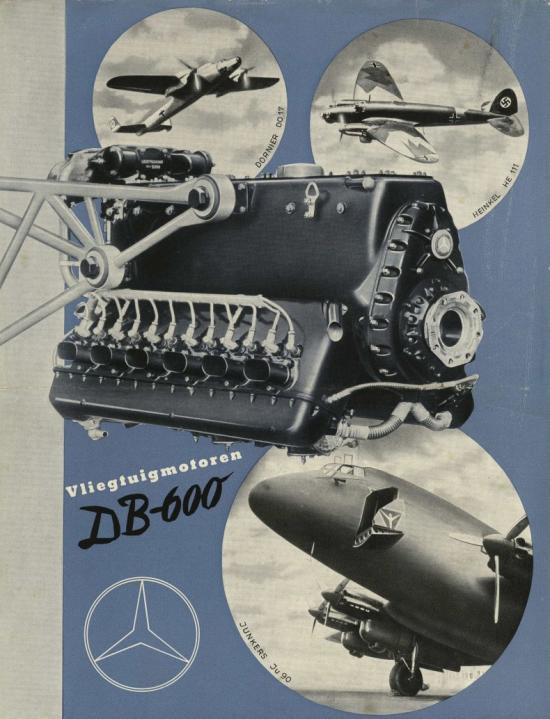
Source : http://www.xs4all.nl/~jqmgrdyk/db600/
Do 17P

Dornier Do 17 P-1 'Glitzer Mary' - 3.(F)/123.
© Thomas A. Tullis - www.tullisart.com
Le Do 17 P-1 fut fabriqué en petit nombre avec les radiaux BMW 132N de 865 CV (645 kW) (moins de consommation de fuel). Deux autres prototypes avec des moteurs DB 600 furent fabriqués en tant que Do 17 R-0, mais ne furent pas produits. A cause d'une réduction de chasseurs de nuit, au moins un Do 17 P-1 fut assigné à ce rôle au sien de la Luftflotte 1 avec une mince tôle métallique au lieu du nez de verre et trois canons MG 151/20.
The Do 17 P-1 was produced in some numbers with the BMW 132N radials of 865 HP (645 kW) (lower fuel consumption). Another two prototypes with DB 600 engines were produced as the Do 17 R-0, but did not enter production. Due to a shortage of Night fighters at least one Do 17P-1 was assigned to this role in the Luftflotte 1 with a smooth metal sheet in place of its glass nose and three MG 151/20 cannons.
Do 17S & U
A cause des chasseurs plus rapides, un nouveau cockpit fut dessiné pour donner à l'équipage plus de place et une meilleure visibilité. Les mitrailleuses dorsale et ventrale furent placées à l'arrière de la cellule où elles avaient un bien meilleur angle de tir. Trois prototypes avec les moteurs DB 600 V12 furent fabriqués sous le nom Do 17 S-0 comme versions de reconnaissance mais ne furent pas mis en production. Quinze modèles d'éclairage furent fabriqués sous le nom de Do 17 U-1, similaires au S-0 mais avec un membre d'équipage supplémentaire (ce qui portait le total à cinq) pour opérer un équipement radio supplémentaire. Les modèles U volaient en avant des autres bombardiers en missions nocturnes, repérant les cibles et larguant des marqueurs dessus. Ils furent spécifiquement demandés par le KG 100 à titre de modèles expérimentaux pour cette fonction.
Because of faster monoplane fighters, a new cockpit was designed to give the crew more room and better visibility. The dorsal and ventral guns were moved to the rear of the pod where they had a considerably better field of fire. Three prototypes with the DB 600 V12 engines were constructed as the Do 17 S-0 reconnaissance version, but it did not go into production. An additional fifteen Do 17 U-1 pathfinder models were built, similar to the S-0 but adding an additional crewman (taking the total to five) to operate the extra radio equipment. The U models were to fly in ahead of other bombers on night missions, locating the target and dropping flares on it. They were personally requested by KG 100 as experimental models for this role.
Do 17Z

Dornier Do 17 Z-1 - 9./KG 76, Cormeilles-en-Vexin (France)
Juillet 1940 - July 1940.
Artiste inconnu - artist unknown - source : http://wp.scn.ru/en/ww2/b/325

Dornier Do 17 Z-2 - unité inconnue - unit unknown.
© Arkadiusz Wróbel
La production à grande échelle fut définitivement celle des modèles Do 17Z. Un premier lot de Z-0 fut fabriqué avec le Fafnir pour les tests. Ils furent rapidement remplacés par le modèle Z-1 sur lequel fut ajouté une autre mitrailleuse mais dont le poids supplémentaire ramena la charge de bombe à 500 kg. Le Do 17 Z-2 fut équipé de la nouvelle version du 323P Fafnir de 1000 CV (750 kW), améliorant ainsi la performance à basse altitude. L'augmentation de puissance permit de remonter la charge de bombe à 1000 kg. Mais les nouveaux moteurs consommaient beaucoup à basse altitude et le rayon d'action avec 1000 kg de bombes était raccourci à 330 km (205 miles). L'armement fut ensuite amélioré par l'addition d'une paire de mitrailleuses supplémentaire tirant sur les côtés supérieurs de la cellule, mais les trois mitrailleuses étaient actionnées par le même mitrailleur.Les modifications du Z-2 de base donnèrent le Z-3 et le Z-6, une version de reconnaissance, le Z-4 à double commande pour l'entraînement, et le Z-5 équipé de cellule de flotaison dans le fuselage et les nacelles moteurs en cas d'atterissage forcé sur l'eau.
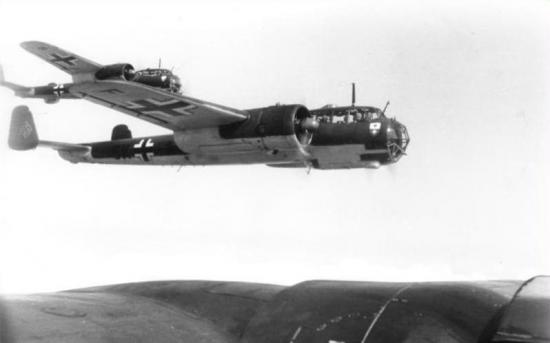
Do 17 Z - KG 3 - © Gentsch Bundesarchiv Bild 101I-343-0679-14A
Septembre - Octobre 1940 - September - October 1940.
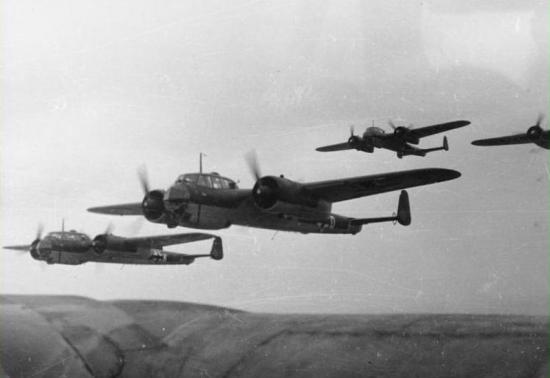
Do 17 Z © Kettelhohn - Bundesarchiv Bild 101I-342-0603-25
(Ces images sont soumises aux droits de Creative Commons Attribution ShareAlike 3.0 Germany License)
(These pictures are licensed under Creative Commons Attribution ShareAlike 3.0 Germany License)
Wide-scale production finally settled on the definitive Do 17Z models. At first a batch of Z-0s were built with the Fafnir for testing. These were quickly replaced with the Z-1 model, which added another gun but the additional weight meant the bombload was reduced to 500 kg. The Do 17 Z-2 mounted the new 323P version of the Fafnir with 1,000 HP (750 kW), improving low-level performance. The increase in power allowed the bombload to be increased to 1,000 kg. But the new engines were also quite "thirsty" at low altitudes, and the combat range with a 1,000 kg bombload was a very short 205 miles (330 km). The armament was further upgraded by adding an additional pair of guns firing out of the sides of the upper part of the pod, but the three guns were all fired by a single gunner.
Modifications of the basic Z-2 model included the Z-3 and Z-6, the reconnaissance version, the Z-4 dual-control trainer, and the Z-5 which included floatation cells in the fuselage and engine nacelles in case it was forced down on water.
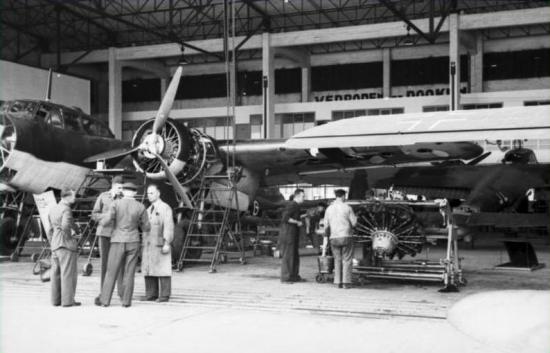
Do 17 Z © Gentsch Bundesarchiv Bild 101I-343-0663-17
Avec les moteurs Bramo 323 Fafnir, septembre-octobre 1940.
With Bramo 323 fafnir powerplant, September - October 1940.
(Cette image est soumise aux droits de Creative Commons Attribution ShareAlike 3.0 Germany License)
(This picture is licensed under Creative Commons Attribution ShareAlike 3.0 Germany License)
Do 17Z-7 / Z-10 Krauz I/II

Dornier Do 17 Z-7 - I./NJG 2
Gilze-Rijen (Pays-Bas), mars 1941 - Gilze-Rijen (Netherlands), March 1941.
Artiste inconnu - artist unknown - source : http://wp.scn.ru/en/ww2/b/325

Dornier Do 17 Z-10 (Hauptmann Erich Jung, Staffelkapitän) - 2./NJG 2
Gilze-Rijen (Pays-Bas), automne 1940 - Gilze-Rijen (Netherlands), Autumn 1940.
Artiste inconnu - artist unknown - source : http://wp.scn.ru/en/ww2/b/325
Après que la production de bombardiers soit terminée en 1940, le modèle Z fut modifié avec un nez "plein" issu du Ju 88C, équipé d'un canon MG FF de 20 mm et trois MG 17 de 7,92 mm pour être utilisé en chasseur de nuit. Trois prototypes furent fabriqués et appelés Do 17 Z-7 Kauz I. Plus tard, le modèle fut modifié en Do 17 Z-10 Kauz II, le nez plein contenant alors une lampe de recherche Infra Rouge (système de détection Spanner). Le Z-10 était armé de quatre mitrailleuses MG 17 de 7,92 mm groupées au dessus de la lampe Infra Rouge et deux canon MG FF de 20 mm en partie basse du nez. Seulement dix de ces Kauz II furent convertis à partir de fuselage de la série Z. Le système Spanner se révéla sans utilité et beaucoup de Z-10 furent laissés sans système de détection. Au moins un Z-10, immatriculé CD+PV, fut utilisé comme avion test pour aider au développement du system de radar Lichtenstein fin 1941/1942.
After bomber production ended in 1940, the Z model was modified with a "solid" nose from the Ju 88C, fitted with one 20 mm MG FF cannon and three 7.92 mm MG 17s, to be used as night fighters. Three prototypes were built called Do 17 Z-7 Kauz I . Later the design was modified to the Do 17 Z-10 Kauz II, the solid nose now containing an Infra Red searchlight (Spanner detection system). The Z-10 was armed with four 7.92 mm MG 17 machine guns grouped above the IR light and two 20 mm MG FF in the lower nose. Only ten of these Kauz II designs were converted from existing Z-series airframes. The Spanner system proved to be essentially useless and many Z-10 were left without detection system. At least one Z-10, coded CD+PV, was used as a flying test aircraft to help developing the Lichtenstein radar system in late 1941/1942.
Do 215

Dornier Do 215 - Aufkl.Gr.Ob.d.L
Utti, Finlande, juillet 1941 - Utti, Finland, July 1941.
© Thomas A. Tullis - www.tullisart.com
Le Do 215 fut développé comme version export du Do 17Z et utilisé comme bombardier, avion de reconnaissance et chasseur de nuit.
The Do 215 was developed as an export version of the Do 17Z series and used as a bomber, reconnaissance and night fighter aircraft.
Production
1985 Dornier Do 17 ont été fabriqués par les Allemands - 1,985 Dornier Do 17 were built by the Germans.
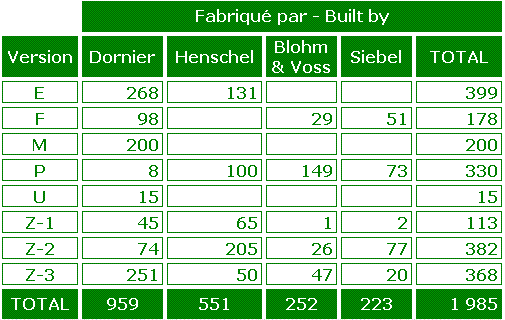
Fiche technique - Technical data
Dornier Do 17 Z-2
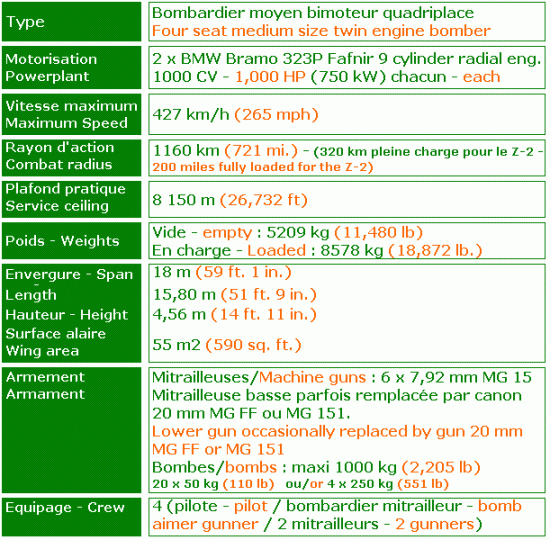
Théâtres d'opérations
Operational history
Les premiers Kampfgeschwaders Dornier
The first Dornier Kampfgeschwaders
Fin 1936, les Do 17 E-1 furent fabriqués en nombre pour les ‘Kampfgeschwader' 153 (KG 153) et KG 155. L'unité de reconnaissance 'Aufklärungsgruppe' (F)/122 commença à se convertir au Do 17 F-1. Début 1937, le KG 255 fut également équipé de Dornier Do 17 E-1. Le 12 mars 1938, des Do 17 E du KG 155 lâchèrent des prospectus pro-nazis sur la ville de Vienne, en prelude à l'occupation de la ville pendant la période de l'Anschluss. Le KG 153 fur renommé KG 3 le 1er mai 1939. Le KG 252 fur aussi équipé de Do 17 M en 1938 pour faire face à la menace de la crise des Sudètes. Le 1er mai 1939, il fut renommé KG 2.
In late 1936 the Do 17 E-1 began to be mass produced for the ‘Kampfgeschwader' 153 (KG 153), and KG 155. The reconnaissance unit ‘Aufklärungsgruppe' (F)/122 began converting to the Do 17 F-1. In early 1937, the KG 255 was also equipped with the Dornier Do 17 E-1. On 12 March 1938, Do 17Es of KG 155 dropped pro-Nazi leaflets on the city Vienna, as a prelude to the city's occupation during the ‘Anschluss' period. The KG 153 was redesignated KG 3 on 1 May 1939. The KG 252 was also equipped with the Do 17 M in 1938 to meet the threat of the Sudeten crisis. On 1 May 1939, it was redesignated KG 2.
La guerre civile espagnole
The Spanish civil war

Dornier Do 17P-1, Aufklärungsgruppe 88 - Burgos (Espagne - Spain), 1937
Artiste inconnu - Artist unknown - Source : http://wp.scn.ru/en/ww2/b/325

Dornier Do 17E-1, Aufklärungsgruppe 88 - Buñuel-Tudela (Espagne - Spain), 1938
Artiste inconnu - Artist unknown - Source : http://wp.scn.ru/en/ww2/b/325
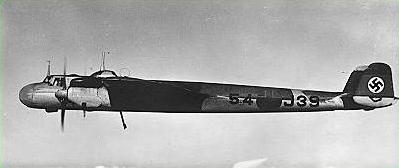
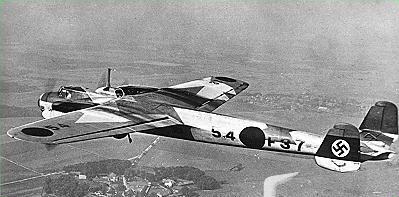
Dornier Do 17E © Sea Bird Publishing, Inc.
Le baptême du feu du Do 17 arriva pendant la Guerre Civile Espagnole (1936-1939), où il fut plutôt performant. Les Espagnols le surnomèrent la Bacalaos (Morue). Début 1937, le Do 17 E-1 devait remplacer le bombardier Heinkel 111B vieillissant de la Légion Condor tandis que le Do 17 F-1 devait remplacer le Heinkel He 70 comme avion de reconnaissance rapide de haute altitude. Cependant, de plus en plus d'avions Républicains modernes fournis par les Soviétiques étaient capables d'intercepter les versions E et F, ce qui précipita l'amélioration de l'armement défensif des Dornier.
Le 6 janvier 1937, il fut décidé d'envoyer 12 Do 17 E-1, ainsi que des He 111 B-1 et des Ju 86 en Espagne. L'unité fut appelée VB/88 (Versuchsbomben Staffel, signifiant Escadrille Expérimentale de Bombardement). Les Dorniers de la VB/88 furent impliqués dans une attaque près de Guernica, larguant huit tonnes de bombes sur un pont. Le 8 juillet 1937, les Dorniers effectuèrent plusieurs sorties pour protéger les forces Nationalistes qui maintenant menaçaient Madrid. A ce stade, les Junkers Ju 86 furent retirés et remplacés par les Do 17 F. Au printemps 1938, une autre unité, la 1.A/88, équipée de Do 17, arriva également en Espagne.
The Do 17's baptism of fire came during the Spanish Civil War (1936-1939), where it performed well. The Spanish nicknamed the Dornier the Bacalaos, (Codfish). In early 1937, the Do 17 E-1 was to supplant the Condor Legion's aging Heinkel He 111B bomber while the Do 17 F-1 was to replace the Heinkel He 70 as a high-flying fast reconnaissance aircraft. However, more modern Soviet-supplied Republican aircraft were capable of intercepting the E and F variants, which prompted an upgrade of the Dornier's defensive armament.
On 6 January 1937, it was decided to send 12 Do 17 E-1s, as well as He 111 B-1s and Ju 86 D-1s in Spain. The unit was named VB/88 (Versuchsbomben Staffel, meaning Experimental Bomber Squadron). VB/88s Dorniers were involved in a strike around Guernica, dropping eight tonnes of bombs on a bridge. On 8 July 1937 the Dorniers flew multiple sorties to protect Nationalist forces now threatening Madrid. At this point the Junkers Ju 86s had been withdrawn and replaced with the Do 17 Fs. In the spring of 1938 another unit, 1.A/88, equipped with Do 17s also arrived in Spain.





